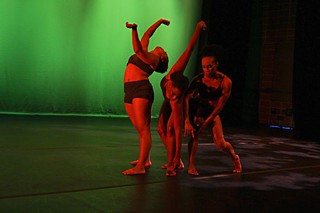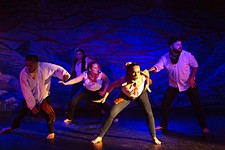A Frique of Nature
Three dancers surrendering their bodies to empathy made for a poignant and transcendant work
Reviewed by Jonelle Seitz, Fri., July 13, 2012
A Frique of Nature
Rollins Studio Theater at the Long Center, 701 W. RiversideJuly 7
A third of the way into the annual Long Center performance by China Smith's Ballet Afrique, to an a cappella version of "Strange Fruit," three female dancers emerged on the floor, crawling and rolling in from the corners of the stage. Like mercury, they merged, unfolding into a single tree-like sculpture, arms liquidly forming branches and faces turned away. In fact, it seemed that I hardly saw the faces of Smith, Daniele Martin, and Janelle Townsel as they danced this section, even as they broke away from the sculpture, their individual pleadings pausing in stark translations – body drooping forward, arms hanging down at the sides; a one-arm-raised slightly swinging stance – of the song on "hanging."
In this section – which was part choreography by Smith in collaboration with Martin, part improvisation – the dancers surrendered their bodies to empathy. To try with all one's might to invoke another's physically bound experience, to invite possession – this, I think, is one of the most powerful offerings of narrative dance. (Another example is Sharon Marroquín's 2008 "Crandall Canyon Mine," in which she, as the miner's widow, took over his movement sequence.) To let someone else in, the dancer must first open herself, and that vulnerability and the inevitable return to the real, fleshbound world make such a situation terribly poignant. When the trio of Ballet Afrique dancers returned to the tree vignette at the end of the song, the stubbornness of the past was made clear. Like the triangular formation of the dancers at the opening of Alvin Ailey's Revelations, this tree, transcendently beautiful but impossibly heavy with its burden, is an image I won't forget.
The "Strange Fruit" section, however, was just one part of the seven-section production that bowed to history and explored contemporary identity, specifically of African American women. In their journeys to accept and heal, to forge identity yet run with a larger society whose homogeny is incompatible with some aspects of their reality, the women appealed to God and each other, helped by texts and songs by the likes of Jill Scott and Lauryn Hill. Whenever choreographed angst veered toward flatter tropes, the movement almost always dissolved into the honest statements and questions of a dozen individual dancers. Hair became a metaphor for "going natural" on a larger scale, embodied by the youngest cast members, a band of thrillingly exuberant and talented teenagers, both girls and boys. Smith's keen sense of theatrics (and good sense to limit the show to about an hour) made for a well-rounded, unfailingly interesting production.











